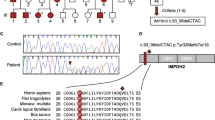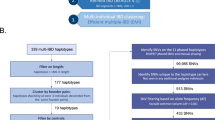Abstract
Dopa–responsive dystonia (DRD) is an autosomal–dominant neurological disorder which appears to result from a genetically determined deficiency of striatal dopamine. Pathological evidence suggests that this may be due to the establishment of a reduced number of dopaminergic nerve terminals in the striatum, or to an excessive reduction (pruning) of these terminals in early development. We have mapped the DRD gene to chromosome 14 by linkage analysis in 3 families with a maximum 2–point lod score of 4.67 at 8.6 centiMorgans from D14S63 maximum multipoint lod scores >6 were obtained for the intervals D14S47–D14S52 and D14S52–D14S63. The flanking loci D14S47 and D14S63 define a region of about 22 cM as containing the DRD gene.
This is a preview of subscription content, access via your institution
Access options
Subscribe to this journal
Receive 12 print issues and online access
$209.00 per year
only $17.42 per issue
Buy this article
- Purchase on Springer Link
- Instant access to full article PDF
Prices may be subject to local taxes which are calculated during checkout
Similar content being viewed by others
References
Fahn, S., Marsden, C.D. & Calne, D.B. Classification and investigation of dystonia. In Movement disorders 2 (eds Marsden, C.D. & Fahn, S.) 332–358 (Butterworths, London, 1987).
Nygaard, T.G., Marsden, C.D. & Duvoisin, R.C. Dopa-responsive dystonia. Adv. Neurol. 50, 377–384 (1988).
Fahn, S. Clinical variants of idiopathic torsion dystonia. J. Neurol. Neurosurg. Psychiatry Supplement, 96–100 (1989).
Nygaard, T.G., Marsden, C.D. & Fahn, S. Dopa-responsive dystonia: Long-term treatment response and prognosis. Neurology 41, 174–181 (1991).
Nygaard, T.G. An analysis of North American families with dopa-responsive dystonia. in Hereditary progressive dystonia with marked diurnal fluctuation (ed. Segawa, M.) 97–104 (Parthenon Publishing, Camforth, 1993).
Nygaard, T.G. Dopa-responsive dystonia: delineation of the clinical syndrome and clues to pathogenesis. Adv. Neurol. 60, 577–585 (1993).
LeWitt, P.A. et al. Tetrahydrobiopterin in dystonia: identification of abnormal metabolism and therapeutic trials. Neurology 36, 760–764 (1986).
Fink, J.K. et al. Dystonia with marked diurnal variation associated with biopterin deficiency. Neurology 38, 707–711 (1988).
Fink, J.K. et al. Tetrahydrobiopterin administration in biopterin-deficient progressive dystonia with diurnal variation. Neurology 39, 1393–1395 (1989).
Nygaard, T.G. et al. Long-term treatment response and fluorodopa positron emission tomographic scanning of parkinsonism in a family with dopa-responsive dystonia. Ann. Neurol. 32, 603–608 (1992).
Rajput, A.H., Gibb, W.R.G., Kish, S.J. & Hornykiewicz, O. Dopa-responsive dystonia - clinical, pathological and biochemical studies in one case. Mov. Disord. 7, 124 (1992).(Abstract)
Fletcher, N.A. et al. Tyrosine hydroxylase and levodopa responsive dystonia. J. Neurol. Neurosurg. Psychiatry 52, 112–114 (1989).
Kwiatkowski, D.J. et al. Identification of a highly polymorphic microsatellite VNTR within the argininosuccinate synthetase locus: exclusion of the dystonia gene on 9q32–34 as the cause of dopa-responsive dystonia in a large kindred. Am. J. hum. Genet. 48, 121–128 (1991).
Schuback et al. Dopamine β-hydroxylase gene excluded in four subtypes of hereditary dystonia. Hum. Genet. 87, 311–316 (1991).
NIH/CEPH Collaborative Mapping Group, A Comprehensive Genetic Linkage Map of the Human Genome. Science 258, 67–86 (1992).
Wang, Z.Y. & Weber, J.L. Continuous Linkage Map of Human Chromosome-14 Short Tandem Repeat Polymorphisms. Genomics 13, 532–536 (1992).
Weissenbach, J. et al. A second-generation linkage map of the human genome. Nature 359, 794–801 (1992).
Ozelius, L. et al. Human gene for torsion dystonia located on chromosome 9q32–q34. Neuron 2, 1427–1434 (1989).
Kramer, P.L. et al. Dystonia gene in Ashkenazi Jewish population is located on chromosome 9q32–34. Ann. Neurol. 27, 114–120 (1990).
Kupke, K.G., Lee, L.V. & Muller, U. Assignment of the X-linked torsion dystonia gene to Xq21 by linkage analysis. Neurology 40, 1438–1442 (1990).
Wilhelmsen, K.C. et al. Genetic mapping of lubag (X-Linked Dystonia-Parkinsonism) in a Filipino kindred to the pericentromeric region of the: chromosome. Ann. Neurol. 29, 124–131 (1991).
Zeman, W. Pathology of the torsion dystonias (dystonia musculorum deformans). Neurology 20 (suppl 2), 79–88 (1970).
Hornykiewicz, O., Kish, S.J., Becker, L.E., Farley, I. & Shannak, K. Biochemical evidence for brain neurotransmitter changes in idiopathic torsion dystonia (dystonia musculorum deformans). Adv. Neurol. 50, 157–165 (1988).
Altrocchi, P.H. & Forno, L.S. Spontaneous oral-facial dyskinesia: neuropathology of a case. Neurology 33, 802–805 (1983).
Waters, C.H. Neuropathology of Lubag (X-linked dystonia-parkinsonism). Movement Disord. 8, 387–390 (1993).
Bemheimer, H., Birkmayer, W., Hornykiewicz, O., Jellinger, K. & Seitelberger, F. Brain dopamine and the syndromes of Parkinson and Huntington: Clinical, morphological, and neurochemical correlations. J. neurol. Sci. 20, 415–455 (1973).
McGeer, P.L., McGeer, E. G. & Suzuki, J. S. Aging and extrapyramidal function. Arch. Neurol. 34, 33–35 (1977).
Hazan, J. et al. Autosomal dominant familial spastic paraplegia is genetically heterogeneous and one locus maps to chromosome 14q. Nature Genet. 5, 163–167 (1993).
Nygaard, T.G., Trugman, J.M., de Yebenes, J. G. & Fahn, S. Dopa-responsive dystonia: The spectrum of clinical manifestations in a large North American family. Neurology 40, 66–69 (1990).
Bressman, S.B. et al. Idiopathic dystonia among Ashkenazi Jews: evidence for autosomal dominant inheritance. Ann. Neurol. 26, 612–620 (1989).
Sharma, V., Smith, L., Allen, L., Magenis, R.E. & Litt, M. Dinucleotide repeat polymorphism at the D14S43 locus. Nucl. Acids Res. 19, 1722 (1991).
Kwiatkowski, D.J. et al. Construction of a GT polymorphism map of human 9q. Genomics 12, 229–240 (1992).
Straub, R.E. et al. A microsatellite genetic linkage map of human chromosome-18. Genomics 15, 48–56 (1993).
Lander, E.S. & Green, P. Construction of multilocus genetic linkage maps in humans. Proc. natn. Acad. Sci. U.S.A. 84, 2363–2367 (1987).
Cox, T.K., Perlin, M. & Chakravarti, A. MultiMap: automatic construction of linkage maps. Am. J. hum. Genet. 51 (suppl 4), A33 (1992).
Dausset, J. Le centre d'etude du polymorphism humain. Presse Med. 15, 1801–1802 (1986).
Boehnke, M. Allele frequency estimation from data on relatives. Am. J. hum. Genet. 48, 22–25 (1991).
Lathrop, G.M., Lalouel, J.M., Julier, C. & Ott, J. Strategies for multilocus linkage analysis in humans. Proc. natn. Acad. Sci. U.S.A. 81, 3443–3446 (1984).
Braverman, M.S. An algorithm to improve the computational efficiency of genetic linkage analysis. Comp. biomed. Res. 8, 24–36 (1985).
Author information
Authors and Affiliations
Rights and permissions
About this article
Cite this article
Nygaard, T., Wilhelmsen, K., Risch, N. et al. Linkage mapping of dopa–responsive dystonia (DRD) to chromosome 14q. Nat Genet 5, 386–391 (1993). https://doi.org/10.1038/ng1293-386
Received:
Accepted:
Issue Date:
DOI: https://doi.org/10.1038/ng1293-386
This article is cited by
-
An unusual presentation of tyrosine hydroxylase deficiency
Journal of Clinical Movement Disorders (2017)
-
Dopa-responsive dystonia—clinical and genetic heterogeneity
Nature Reviews Neurology (2015)
-
GCH1 heterozygous mutation identified by whole-exome sequencing as a treatable condition in a patient presenting with progressive spastic paraplegia
Journal of Neurology (2014)
-
Dystonien
Der Nervenarzt (2008)
-
A novel mutation in GCH-1 gene in a case of dopa-responsive dystonia
Journal of Neurology (2007)



